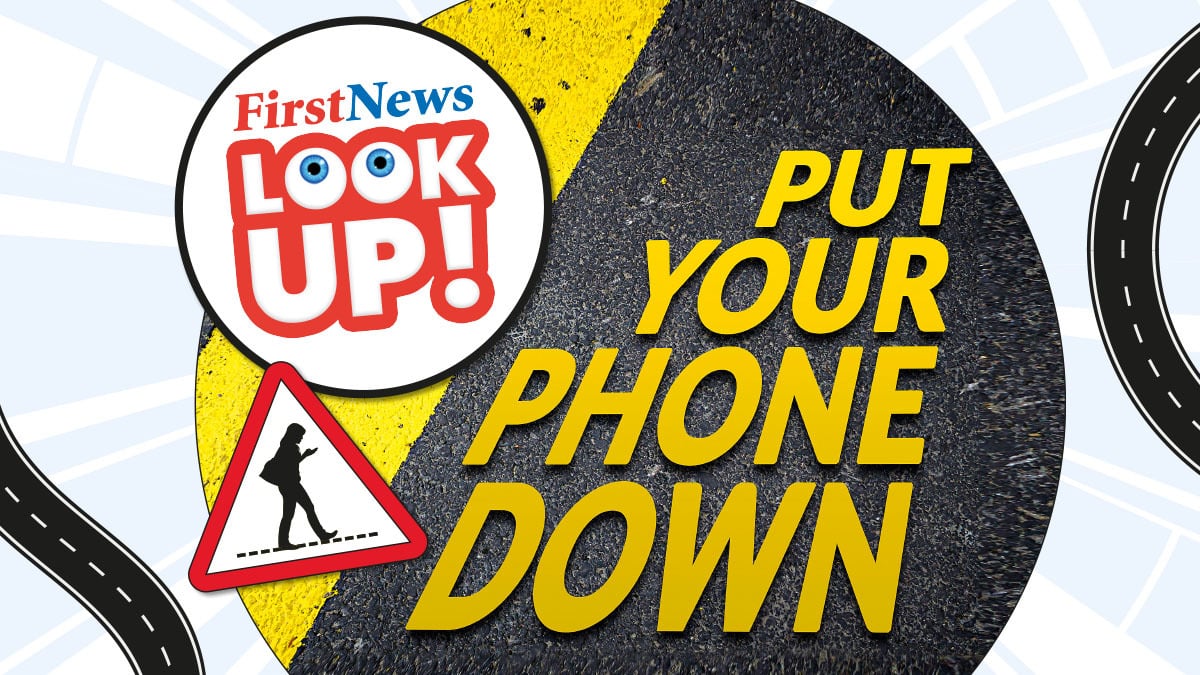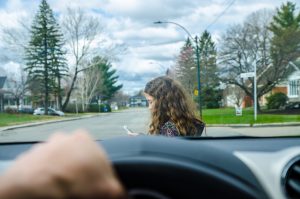Look Up!
Published: 6th September 2023
Updated: 23rd September 2024
Published: 6th September 2023
Updated: 23rd September 2024
First News is calling on every school to hold a Look Up! assembly to warn you about the dangers of looking at your phone while crossing the road.

Although many people are distracted by mobile phones, children are the most affected. By the age of 12, nearly all children have a phone and there is a clear link between the use of mobile devices and the time of serious accidents involving children, particularly at the end of the school day.
THE NUMBERS ARE SHOCKING
Road accidents are one of the main reasons that young people die. The 2023 Government figures show that 4,577 pedestrians, aged 15 and under, were hurt on UK roads last year. That’s 88 children every week.
Tragically, 1,340 of those were either killed or left with serious, life-changing injuries. That’s nearly four child pedestrians a day, or a class of 26 children EVERY week!
Government public health experts, who are working to reduce the number of child injuries on the roads, say the largest number of child pedestrian injuries take place between 8 am and 9 am and between 3 pm and 7 pm. Further data shows that children aged 12 are the most likely to be involved in an accident, as they are walking independently to, and from, school for the first time.
“Every hour of every day, a teen is hit or killed while walking. Texting and walking can be fatal. That’s why we’re asking everyone to put phones down when crossing the street.” Safe Kids Worldwide

THE EVIDENCE
Although many people get distracted by their phones while out and about, children are the most affected. And, with research carried out by Childwise revealing that 53% of children in the UK own a mobile phone by the age of seven, it’s not surprising that it’s turning into a problem. Different studies over the years have shown that phones are a growing distraction for pedestrians, affecting whether they cross a road safely. There’s even a name for people distracted by their phones: SMOMBIES (smartphones + zombies).
While almost a third of Brits admitted to using their phone when crossing the road in 2021, research carried out by AXA insurance company found that 21% of 11-year-olds and 25% of 12-year-olds say that they have been distracted by a screen while crossing a road.
To find out more, The University of Calgary pulled together data from 33 studies and looked at the impact of phones on road safety. They looked at how long it took 808 children and adults to start walking, begin and complete crossing a road, whenever they looked left or right and if there were any collisions and close calls with other pedestrians and vehicles. They found that, while talking on the phone made people take longer to cross the road, texting was the most dangerous action as it stopped people looking left and right as much as they should.
Another study by the University of Lincoln in 2019 looked at mobile phone use by schoolchildren while crossing the road. They watched pupils outside a secondary school in the north of England over a four-week period. They wanted to see if the pupils looked (or didn’t look) left and right before crossing the road, whether they crossed when the pedestrian light was on red or green and whether they crossed on the crossing.
The researchers found that nearly a third (31.37%) of road crossings were made by pupils with a phone or other device, and that they looked left and right less frequently when they had them. They concluded that the safety of school-age pedestrians is affected by mobile phones and music players.
Studies in other countries such as Australia, Serbia and the US also found that pedestrians who were talking or texting on a mobile phone looked for traffic less often than others. Some countries and some states in the US have made it against the law to cross a road while using a phone.
Laboratory simulations have also shown that child pedestrians walked slower when talking on a mobile phone, paid less attention to traffic, allowed less time to cross when a car was coming towards them, and had more traffic hits and near misses when using a mobile phone.
The 2019 official road safety numbers showed that children aged 11 and 12 were the most at risk of serious accidents while walking on UK streets. The number of children killed or seriously injured more than doubled from 83 ten-year-olds to 172 11-year-olds – the age many children begin to travel on their own to and from school for the first time. This is also the age by which most children have their own phone to stay in touch with family.
A PROBLEM FOR YEARS
The danger of mobile phone distraction has been known about for many years. As long ago as 2014, insurance firm AXA brought out a safety report which said that a quarter of children admitted they paid more attention to their phones than traffic when crossing roads. With nearly one in five pupils saying they had to cross five or more roads on their school journeys, the dangers are obvious.
The problem seems to have got worse since then. In 2016, research released by Safe Kids Worldwide found that half of teenagers said they crossed streets while reading a mobile device, and an alarming four out of ten admitted to actually being hit or nearly hit by a car, bike or motorbike while walking. The organisation says: “Every hour of every day, a teen is hit or killed while walking. Texting and walking can be fatal. That’s why we’re asking everyone to put phones down when crossing the street.”
HOPING OTHERS LEARN FROM SIAN’S DEATH
A teenager died after walking in front of a bus while distracted by her mobile phone. Sian Ellis, 15, suffered fatal injuries when she was hit by a double-decker bus outside her school in Leicestershire on 28 January 2019. The accident happened shortly after 3:30pm, just metres from the gates of King Edward VII College. Giving evidence at the inquest (official investigation) into her death, PC Stuart Bird, a collision investigator with Leicestershire Police, said CCTV footage taken shortly before the tragedy showed a female matching Sian’s description “walking through the school grounds wearing a scarf around her head and looking down at her mobile phone”. His colleague, Detective Constable John Borlase, said witnesses had told him Sian was looking down at her mobile and was also using headphones. Sian’s devastated family issued a warning to other youngsters about the use of their phones near traffic. “While we have to come to terms with this tragic accident, we must try to help others learn from it and to stress the dangers of the use of mobile phones and the distractions that these can cause when walking by and crossing busy roadways. We see this every day and hope that, if anything good can come from this, it is that other children (and adults) will have learned not to put themselves in similar danger.”
HOLD AN ASSEMBLY AT YOUR SCHOOL
First News has created a free Look Up! assembly pack for every school so you remember to put down your phones.
Teachers – For the assembly pack, head to first.news/lookupteachers